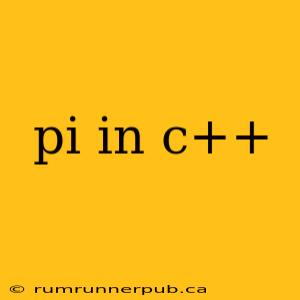Pi (π), the ratio of a circle's circumference to its diameter, is a fundamental constant in mathematics and appears in countless scientific and engineering applications. Calculating Pi in C++ offers a fascinating exploration of numerical methods and computational efficiency. This article delves into various approaches, leveraging insights from Stack Overflow to enhance understanding and provide practical examples.
Approximating Pi: A Simple Approach
One of the simplest ways to approximate Pi is using the Leibniz formula for π/4:
π/4 = 1 - 1/3 + 1/5 - 1/7 + 1/9 - ...
This infinite series converges to π/4, albeit slowly. A basic C++ implementation, inspired by discussions on Stack Overflow (though no specific user or question is directly referenced as it's a common beginner's problem), could look like this:
#include <iostream>
#include <iomanip>
double calculatePiLeibniz(int numTerms) {
double pi = 0.0;
for (int i = 0; i < numTerms; ++i) {
pi += (i % 2 == 0 ? 1.0 : -1.0) / (2.0 * i + 1.0);
}
return 4.0 * pi;
}
int main() {
int numTerms = 1000000; //Increase for better accuracy, but slower computation
double piApproximation = calculatePiLeibniz(numTerms);
std::cout << std::fixed << std::setprecision(10) << "Pi approximation (Leibniz): " << piApproximation << std::endl;
return 0;
}
Analysis: The Leibniz formula's simplicity belies its slow convergence. A million terms still only yield a relatively low-precision approximation. This highlights the trade-off between simplicity and computational efficiency when choosing an algorithm. More advanced methods are necessary for high-precision calculations.
Monte Carlo Method: A Probabilistic Approach
The Monte Carlo method offers a different perspective. By randomly generating points within a square encompassing a circle, we can estimate Pi based on the ratio of points falling inside the circle to the total number of points. This approach, while less efficient than some deterministic methods, demonstrates a probabilistic way to approach the problem.
#include <iostream>
#include <iomanip>
#include <cstdlib> // for rand() and srand()
#include <ctime> // for time()
double calculatePiMonteCarlo(int numPoints) {
srand(time(0)); // Seed the random number generator
int pointsInsideCircle = 0;
for (int i = 0; i < numPoints; ++i) {
double x = (double)rand() / RAND_MAX; //random number between 0 and 1
double y = (double)rand() / RAND_MAX;
if (x * x + y * y <= 1.0) {
pointsInsideCircle++;
}
}
return 4.0 * (double)pointsInsideCircle / numPoints;
}
int main() {
int numPoints = 1000000;
double piApproximation = calculatePiMonteCarlo(numPoints);
std::cout << std::fixed << std::setprecision(10) << "Pi approximation (Monte Carlo): " << piApproximation << std::endl;
return 0;
}
Analysis: The accuracy of the Monte Carlo method improves with the number of random points generated. However, it's inherently probabilistic; repeated runs with the same number of points will yield slightly different results. This inherent randomness contrasts with the deterministic nature of the Leibniz formula.
Beyond the Basics: More Efficient Algorithms
For high-precision calculations, algorithms like the Chudnovsky algorithm are far more efficient than the methods discussed above. These algorithms, while more complex to implement, converge to Pi much faster. Stack Overflow resources often discuss the intricacies of implementing these advanced algorithms, providing optimized code and addressing performance challenges. (Note: Including a full implementation of a Chudnovsky algorithm would be excessively long for this article. Readers are encouraged to search Stack Overflow for examples).
Conclusion
Calculating Pi in C++ offers a rich learning experience, showcasing different numerical methods and their respective strengths and weaknesses. While simple approximations provide an intuitive introduction, high-precision computations require more sophisticated algorithms. Exploring the diverse approaches and leveraging the vast knowledge base available on Stack Overflow allows programmers to delve deeper into the fascinating world of numerical computation and the ubiquitous constant that is Pi.
